 W
WThe Abbey is a science-fiction novel by the Romanian author Dan Doboș. It was first published in 2002 by Editura Nemira.
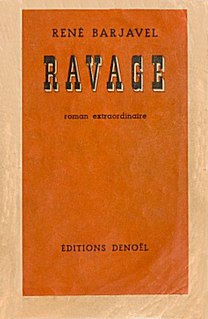 W
WAshes, Ashes is a science fiction novel written by René Barjavel, set in 2052 France. It was first published in 1943 by Denoël. Its English-language translation by Damon Knight as Ashes, Ashes was published in 1967 by Doubleday. Ravage has been included on many "all-time" best lists, including Annick Beguin's Les 100 principaux titres de la science-fiction.
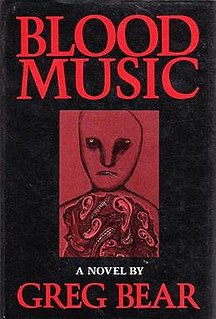 W
WBlood Music is a science fiction novel by American writer Greg Bear. It was originally published as a short story in 1983 in the American science fiction magazine Analog Science Fact & Fiction, winning the 1983 Nebula Award for Best Novelette and the 1984 Hugo Award for Best Novelette.
 W
WThe Camp of the Saints is a 1973 French dystopian fiction novel by author and explorer Jean Raspail. A speculative fictional account, it depicts the destruction of Western civilization through Third World mass immigration to France and the West. Almost forty years after its initial publication, the novel returned to the bestseller list in 2011.
 W
WCat's Cradle is a satirical postmodern novel, with science fiction elements, by American writer Kurt Vonnegut. Vonnegut's fourth novel, it was first published in 1963, exploring and satirizing issues of science, technology, the purpose of religion, and the arms race, often through the use of black humor. After turning down his original thesis in 1947, the University of Chicago awarded Vonnegut his master's degree in anthropology in 1971 for Cat's Cradle.
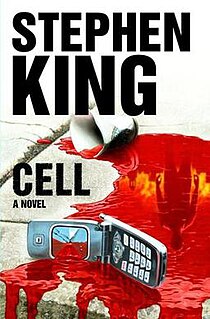 W
WCell is a 2006 apocalyptic horror novel by American author Stephen King. The story follows a New England artist struggling to reunite with his young son after a mysterious signal broadcast over the global cell phone network turns the majority of his fellow humans into mindless vicious animals.
 W
WThe Copper Scroll is a 2006 Christian apocalyptic novel by Joel C. Rosenberg. The novel is the fourth book in the Last Jihad book series. It involves the Biblical prophecies concerning the restoration of the Jewish Temple, tied in by the author to the treasures of the Copper Scroll.
 W
WA Crystal Age is a utopian novel/ Dystopia written by W. H. Hudson, first published in 1887. The book has been called a "significant S-F milestone" and has been noted for its anticipation of the "modern ecological mysticism" that would evolve a century later.
 W
WDarkness and the Light (1942) is a science fiction novel by British writer Olaf Stapledon.
 W
WDead Romance is an original novel by Lawrence Miles, originally published as part of the Virgin New Adventures series. The New Adventures were a spin-off from the long-running British science fiction television series Doctor Who. Though part of the sequence of stories that featured the fictional archaeologist Bernice Summerfield, this was released as something of a standalone, and she is not in it. The main character and narrator Christine Summerfield are not connected to her in any way. A former New Adventures Seventh Doctor companion, Chris Cwej, does appear. The Seventh Doctor briefly appears as "the Evil Renegade" in Chris's tampered memories.
 W
WLe Dernier Homme is a French science fantasy novel in the form of a prose poem. Written by Jean-Baptiste Cousin de Grainville and published in 1805, it was the first story of modern speculative fiction to depict the end of the world. Considered a seminal early work of science fantasy, specifically of the Dying Earth genre, it has been described by Gary K. Wolfe as "A crucial document in the early history... of what became science fiction".
 W
WEvolution is a collection of short stories that work together to form an episodic science fiction novel by author Stephen Baxter. It follows 565 million years of human evolution, from shrewlike mammals 65 million years in the past to the ultimate fate of humanity 500 million years in the future.
 W
WThe Fireman is a post-apocalyptic novel by American author Joe Hill. The novel, his fourth, tells the tale of a deadly spore that has infected most of the world's population. Hill first spoke of the novel in 2013 in promotional interviews for his then-new novel NOS4A2. The novel was released on May 17, 2016.
 W
WFlood is a 2008 work of hard science fiction by English author Stephen Baxter. It describes a near future world where deep submarine seismic activity leads to seabed fragmentation, and the opening of deep subterranean reservoirs of water. Human civilisation is almost destroyed by the rising inundation, which covers Mount Everest in 2052. Baxter issued a sequel to this work, entitled Ark, in 2009.
 W
WThe Forge of God is a 1987 science fiction novel by American writer Greg Bear. Earth faces destruction when an inscrutable and overwhelming alien form of life attacks.
 W
WGood News From Outer Space is a science fiction novel by American writer John Kessel. It is predominantly a satire telling the story of a resurrected reporter, George Eberhart, investigating alien involvement on Earth just prior to worldwide hysteria surrounding the countdown to the year 2000. The book was described as "madcap" and containing "gonzo plotting", which lent itself well to the satirical points Kessel was trying to make.
 W
WGrasshopper Jungle is a 2014 young adult novel written by American author Andrew A. Smith that follows a cast of characters living in the fictional, run-down, half-abandoned town of Ealing, Iowa. The story follows the life of two young high school boys who fight for their lives during an apocalypse.
 W
WThe HAB Theory is a 1976 science fiction novel by American author Allan W. Eckert. The novel is from the apocalyptic fiction subgenre. Eckert believed that the real-world facts and conclusions he quoted in the novel, were worthy of further exploration. One such conclusion was that hyper-specialization in the physical sciences was a big problem and that more interactions between hyper-specialists was overdue. He wove facts and concepts into the novel form, then his 17th book, to get more minds considering them. The book explores a version of pole shift hypothesis postulated by Professor Charles Hapgood in two volumes, plus the 1967 book Cataclysms of the Earth by Hugh Auchincloss Brown.
 W
WIce is a novel by Anna Kavan, published in 1967. Ice was Kavan's last work to be published before her death, the first to land her mainstream success, and remains her best-known work. Generally regarded as genre-defying, it has been labelled a work of science fiction, Nouveau roman, and slipstream fiction.
 W
WThe Kraken Wakes is an apocalyptic science fiction novel by John Wyndham, originally published by Michael Joseph in the United Kingdom in 1953, and first published in the United States in the same year by Ballantine Books under the title Out of the Deeps as a mass market paperback. The title is a reference to Alfred Tennyson's sonnet The Kraken.
 W
WLast and First Men: A Story of the Near and Far Future is a "future history" science fiction novel written in 1930 by the British author Olaf Stapledon. A work of unprecedented scale in the genre, it describes the history of humanity from the present onwards across two billion years and eighteen distinct human species, of which our own is the first. The book employs a narrative conceit that, under subtle inspiration, the novelist has unknowingly been dictated a channelled text from the last human species.
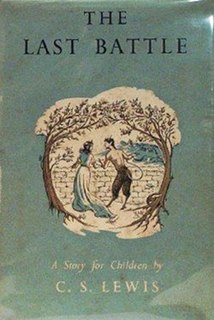 W
WThe Last Battle is a high fantasy novel for children by C. S. Lewis, published by The Bodley Head in 1956. It was the seventh and final novel in The Chronicles of Narnia (1950–1956). Like the other novels in the series, it was illustrated by Pauline Baynes and her work has been retained in many later editions.
 W
WLord of the World is a 1907 dystopian science fiction novel by Monsignor Robert Hugh Benson that centres upon the reign of the Antichrist and the end of the world. It has been called prophetic by Dale Ahlquist, Joseph Pearce, Pope Benedict XVI and Pope Francis.
 W
WThe Messiah Of Morris Avenue is a 2006 novel by English satirist Tony Hendra. The novel depicts the Second Coming of Christ in a future United States ruled by the religious right. Tony Hendra has recorded several "Godcasts" recapping the events that have transpired between now and the second coming.
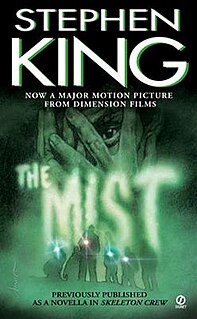 W
WThe Mist is a psychological horror novella by American author Stephen King. First published by Viking Press in 1980 as part of the Dark Forces anthology, an edited version was subsequently included in King's 1985 collection Skeleton Crew. In the story, the small town of Bridgton, Maine is shrouded in a dense mist that conceals otherworldly creatures. The protagonist and narrator David Drayton, who has taken refuge with his young son in a supermarket, tries to survive against not only the creatures of the mist, but also fanatical aggression from other survivors. In The Mist, King addresses the themes of man-made fears and religious fundamentalism.
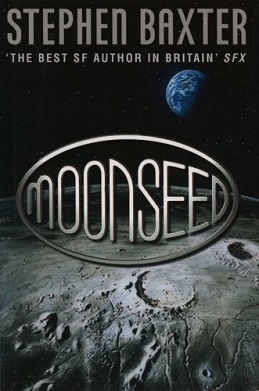 W
WMoonseed is a 1998 science fiction novel by British writer Stephen Baxter. It takes place within his NASA series.
 W
WOmega: The Last Days of the World is a science fiction novel published in 1894 by Camille Flammarion.
 W
WPandemia is a 2006 post-apocalyptic teen novel written by American author Johnathan Rand. The novel depicts a scenario in which bird flu mutates and becomes a global epidemic because of modern transportation methods, eventually causing a universal state of emergency.
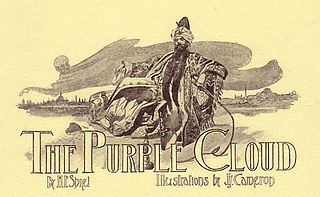 W
WThe Purple Cloud is an apocalyptic "last man" novel by the British writer M. P. Shiel. It was published in 1901. H. G. Wells lauded The Purple Cloud as "brilliant" and H. P. Lovecraft later praised the novel as exemplary weird fiction, "delivered with a skill and artistry falling little short of actual majesty."
 W
WRemnants is a series of science fiction books written by K. A. Applegate and published between July 2001 and September 2003. It is the story of what happens to the survivors of a desperate mission to save a handful of human beings after an asteroid collides with the Earth. Eighty people are placed aboard a converted space shuttle using untested "quack" hibernation technology and fired blindly into space hours before all life on Earth is obliterated by a large asteroid called The Rock. They are then picked up by a large, sentient space craft of monumental proportions known as 'Mother' which is inhabited by various races. 'Mother' can manipulate the physical environment within the craft's limits and often does so. Only a few people placed in stasis actually were alive and capable of being reanimated when they reached 'Mother'.
 W
WRobopocalypse (2011) is a science fiction novel by Daniel H. Wilson. The book portrays AI out of control when a researcher in robotics explores the capacity of robots. It is written in present tense.
 W
WSept cavaliers is a 1993 novel by the French writer Jean Raspail. It tells the story of seven horsemen who are sent to find why their country, a place with traits of both medieval and modern Europe, is becoming devoid of human life. The characters in the novel have names from all parts of Europe. Throughout the narrative are references to the poet Guillaume Apollinaire under his real name Wilhelm Kostrowitsky.
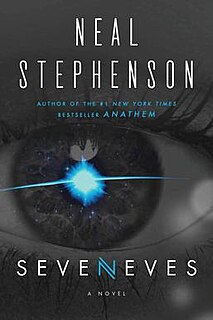 W
WSeveneves is a hard science fiction novel by Neal Stephenson published in 2015. The story tells of the desperate efforts to preserve Homo sapiens in the wake of apocalyptic events on Earth after the unexplained disintegration of the Moon and the remaking of human society as a space-based civilization after a severe genetic bottleneck.
 W
WSeverance is a 2018 satirical science fiction novel by the Chinese-American author Ling Ma. It follows Candace Chen, an unfulfilled Bible product coordinator, before and after Shen Fever slowly obliterates global civilization. Severance explores themes of nostalgia, modern office culture, monotony, and intimate relationships. The novel, Ma's debut, won the 2018 Kirkus Prize for Fiction and was included on many prominent Best Books of 2018 lists.
 W
WSneak is an apocalyptic fiction novel written by Evan Angler and published in 2012. The second book in the Swipe series, it is aimed at a middle grade audience.
 W
WStorm is an apocalyptic fiction novel by Evan Angler and is aimed at a middle grade audience. The third book in the Swipe series, it was published in 2013.
 W
WSwipe is an apocalyptic fiction novel written by Evan Angler and published in 2012. The first book in the Swipe series, it is aimed at a middle grade audience.
 W
WThat Extraordinary Day is a science fiction novel written by Predrag Vukadinović. The novel connects the theme of time travel with the Second Coming of Christ, using cosmological and religious concepts.
 W
WThief of Time is a fantasy novel by British writer Terry Pratchett, the 26th book in his Discworld series. It was the last Discworld novel with a cover by Josh Kirby.
 W
WThe Third World War is an apocalyptic novel, published in 2003 by the British journalist and author Humphrey Hawksley, portraying the modern world as it deals with the ever-worsening geopolitical situation.
 W
WThe Time Machine is a science fiction novella by H. G. Wells, published in 1895 and written as a frame narrative. The work is generally credited with the popularization of the concept of time travel by using a vehicle or device to travel purposely and selectively forward or backward through time. The term "time machine", coined by Wells, is now almost universally used to refer to such a vehicle or device.
 W
WThe Turner Diaries is a 1978 novel by William Luther Pierce, published under the pseudonym Andrew Macdonald. The Turner Diaries depicts a violent revolution in the United States which leads to the overthrow of the federal government, a nuclear war, and, ultimately, a race war which leads to the systematic extermination of non-whites. All groups opposed by the novel's protagonist, Earl Turner, including Jews, non-whites, "liberal actors" and politicians, are exterminated.
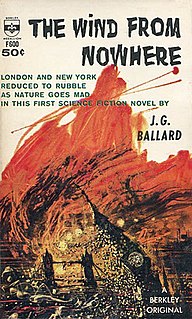 W
WThe Wind from Nowhere is a science fiction novel by English author J.G. Ballard. Published in 1961, it was his debut novel. He had previously published only short stories.
 W
WThe Year When Stardust Fell is a science fiction novel written by Raymond F. Jones. It was initially published in 1958 by the John C. Winston Company.